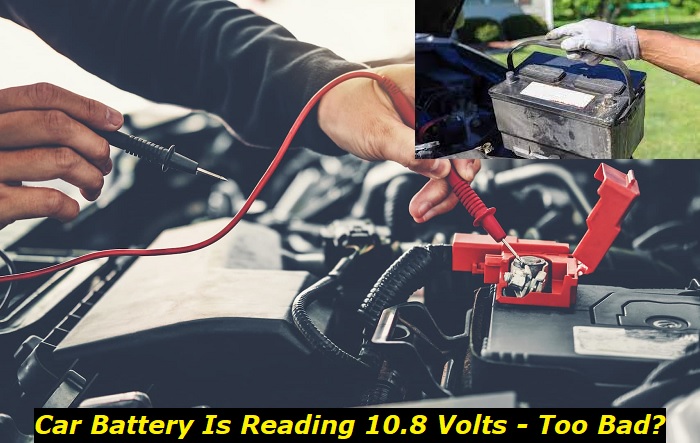If your car won't start and the battery reads 10.8 volts, it could be dead. It's important to know how to check and replace a 12V battery in order to keep yourself safe on the road. Thankfully, checking and replacing a car battery is not as difficult or time-consuming as you may think; with just some basic tools, you can get back on the road quickly.
Car battery voltage highlights
- Optimal conditions:12.4 - 12.5 volts
- When charging:14.3 - 14.7 volts
- Alarming voltage:less than 12 volts
- Acceptable drop when loaded:up to 10.5 volts
- Fix for low voltage:charging or replacement
- DIY fix:possible
- How much to fix? $0 - $250

What voltage should a car battery read to be considered healthy and not in need of replacement?
A healthy car battery should read 12.6 volts or higher when the engine is off and between 13.7 to 14.7 volts when it's running. If the voltage reading is below 12.6 volts with the engine off, this could be a sign that the battery may need to be replaced soon. It's important to check your car battery voltage regularly to ensure it's running as efficiently and safely as possible. This can be done with a multimeter or by taking your car to an auto repair shop for a professional inspection.
What a car battery voltage reading of 10.8 volts means?
A car battery voltage reading of 10.8 volts means that the battery is not receiving a full charge and may need to be replaced or tested further in order to determine the cause. A fully charged car battery should have a voltage above 12.6 volts, so a reading of 10.8 volts suggests that the battery is not being properly charged by the alternator.
This can be caused by a number of issues, such as a faulty alternator, worn-out wiring, or even corrosion on the battery terminals. You may still be able to start your car; however, it is important to get the battery checked and possibly replaced in order to ensure your safety going forward.
How to properly check a car's battery?
- Inspect the battery for any corrosion. Corrosion indicates that there may be a problem with the battery, so it is important to check and clean the battery before testing it.
- Check the fluid level in each cell of the battery. A low fluid level indicates a potential problem and should be addressed.
- Test the battery with a voltmeter to make sure it is producing sufficient power.
- Check that all of the battery connections are tight and free of corrosion, as loose or corroded connections can affect the performance of your car battery and cause it to fail prematurely.
- Test the starting and charging systems, if applicable. A weak or malfunctioning starter or alternator can cause your battery to fail prematurely, even though it may initially test okay with a voltmeter.
- Have the battery load tested at a professional automotive shop to make sure it is providing sufficient power to start the vehicle. Load testing can also diagnose other problems in the battery, such as a bad cell or a weak electrical connection.
- If any of these tests reveal a problem with your battery, replace it with a new one as soon as possible to avoid getting stranded due to a dead battery. Make sure to dispose of the old battery properly.
Following these steps will help to ensure that your car's battery is in good working condition and ready to start the engine when you need it. Taking the time to check and maintain your battery can save you a lot of trouble in the future!
How to replace a 12V car battery?
- Park the car in a safe place and turn off the engine. Make sure to apply the parking brake and set up the wheel chocks so that your vehicle won't roll or move while you are working on it.
- Open up the hood and disconnect the negative terminal of your battery first, followed by the positive terminal. Both of these terminals should be labeled and clearly indicated by the manufacturer. If needed, use a wrench to loosen the clamps before you disconnect them.
- Lift out the battery from its tray and clean off any dirt or corrosion that may have accumulated over time. Be sure to check the posts and cable ends for corrosion as well.
- Place the new battery into the tray and secure it with clamps or brackets if needed.
- Connect the positive terminal first, followed by the negative terminal, to their corresponding posts on the battery.
- Close up the hood and make sure everything is locked securely in place.
- Start the engine to make sure that it is working properly and that your new battery is connected correctly. If all goes well, you have successfully replaced the 12V battery in your car!
Tips for extending the life of your car battery
- Make sure your battery terminals are clean and secure: Over time, battery terminals can become corroded or loose, which prevents the flow of electricity from the battery to other parts of the car. Checking that they're secure and free of corrosion will help ensure your car's electrical system is functioning properly.
- Keep your battery charged: As you use your car, the battery will lose charge. Make sure to keep an eye on it and recharge it when necessary. A good way to do this is by taking a regular drive of at least 30 minutes every few weeks.
- Regularly check the level of electrolytes: The levels of electrolytes in your battery should be checked regularly to make sure that the components are working well together. A low electrolyte level can cause the battery to malfunction, so it's important to keep an eye on it.
- Keep your car cool: Heat is one of the biggest killers when it comes to car batteries. Make sure to park your car in a cool, shaded area when possible, and avoid leaving it in direct sunlight for long periods of time.
- Have your battery regularly serviced: Regular servicing can help extend the life of your car battery. Make sure to take it in for a check-up at least once a year or every few thousand miles.
- Turn off electrical components when not in use: Electrical components such as headlights, the radio, and other accessories draw power from the battery even when your car is not running. Turning them off when you're not using them will help preserve your battery life.
- Switch to a maintenance-free battery: Traditional lead acid batteries require regular maintenance, such as adding water and cleaning. Upgrading to a maintenance-free, sealed battery can help reduce the amount of upkeep needed and extend your car battery's life.
Following these tips will help ensure your car battery is running optimally and will extend its life for years to come.
Bottom Line
Making sure that your car's battery is in good condition and functioning properly is an essential part of vehicle maintenance. Taking the time to regularly check on its status and, if necessary, replace it with a new one will help keep you safe while on the road. Properly following the instructions provided above will ensure that you get the job done right the first time and avoid any potential issues.
Taking the time to properly maintain your car's battery will be worth it in the long run, as it will help you save money from costly repairs and keep you safe on the road. By following these simple steps, you can rest assured that your vehicle is ready for whatever comes your way!
About the authors
The CarAraC research team is composed of seasoned auto mechanics and automotive industry professionals, including individuals with advanced degrees and certifications in their field. Our team members boast prestigious credentials, reflecting their extensive knowledge and skills. These qualifications include: IMI: Institute of the Motor Industry, ASE-Certified Master Automobile Technicians; Coventry University, Graduate of MA in Automotive Journalism; Politecnico di Torino, Italy, MS Automotive Engineering; Ss. Cyril and Methodius University in Skopje, Mechanical University in Skopje; TOC Automotive College; DHA Suffa University, Department of Mechanical Engineering






Add comment